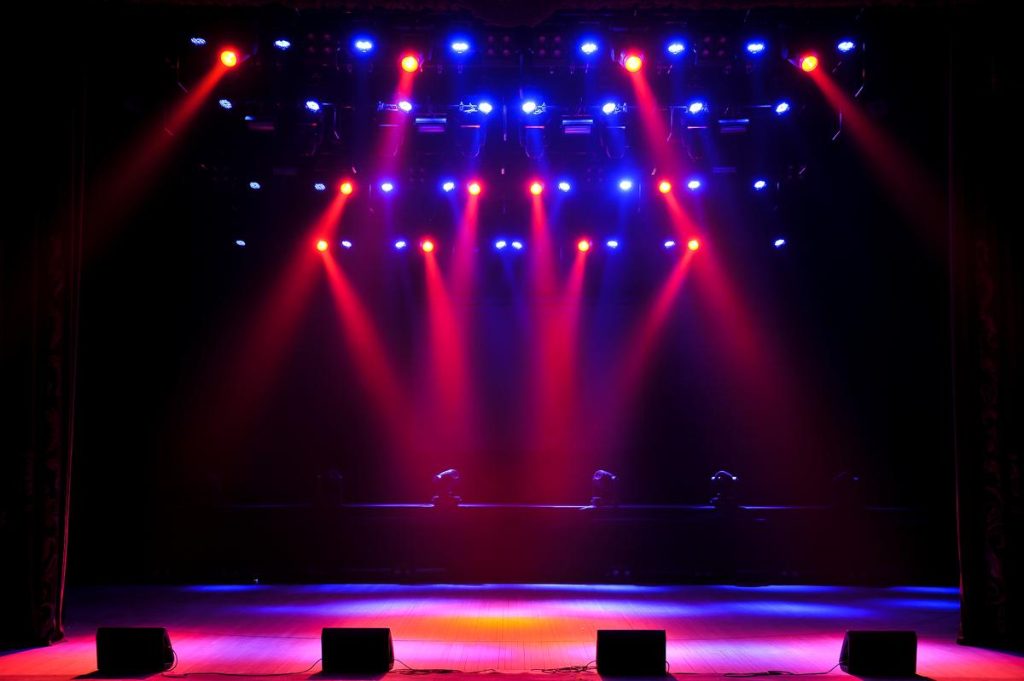You must have been to a theater or a concert, you may have noticed that stages come in different sizes. Have you ever wondered if there is a standard size for stages?
The dimensions of a typical stage can vary, ranging from 8 x 24 feet to a spacious 20 x 30 feet. The size you ultimately choose will depend on the number of individuals who will be occupying the stage simultaneously.
When it comes to determining the appropriate size for a stage rental, the number of band members is a crucial factor to consider. But is renting a stage even necessary in the first place? These questions and more will be addressed in the following segments.
Types of Stages
There are several types of stages used in theater and concert productions, including:
Proscenium Stage
A proscenium stage is the most common type of stage used in theatrical productions. It is a rectangular stage with a large opening called a proscenium arch. The audience sits on one side of the stage, and the performers perform on the other side, separated by the arch.
Thrust Stage
A thrust stage is a stage that extends into the audience. It is surrounded on three sides by the audience, and performers can enter and exit from all sides of the stage.
Arena Stage
An arena stage is a round or oval stage that is surrounded by the audience on all sides. This stage is commonly used for sporting events, concerts, and other performances where the performers need to be visible from all angles.
Black Box Theater
A black box theater is a flexible performance space that can be configured in various ways to suit the needs of the production. It is typically a square or rectangular space with black walls and a black floor.
The Standard Stage Size

Broadway stage size:
The Broadway stage is typically around 40 x 30 feet, with a proscenium opening that is approximately 40 feet wide and 30 feet high. The stage also has a large fly space for elaborate set pieces and multiple levels for performers and stage crew.
West End stage size:
The West End stage is similar in size to the Broadway stage, with a proscenium opening that is around 40 x 30 feet. The stage may also have a deep apron that extends out into the audience area.
Regional theatre stage size:
The size of a regional theatre stage can vary greatly depending on the venue. Some smaller regional theatres may have stages that are only 20 x 15 feet, while larger venues may have stages that are closer in size to those of Broadway or West End theatres.
Television stage size:
Television studios typically have smaller stages than live theatre venues, as the camera angles and lighting requirements are more limited. A standard television studio stage may be around 30 x 20 feet.
Outdoor concert stage size:
Outdoor concert stages can vary greatly in size depending on the type of event and the number of performers. Large outdoor music festivals may have stages that are as wide as 100 feet and as deep as 80 feet, with additional space for backstage areas and equipment storage. Smaller outdoor concerts may have stages that are only 20-30 feet wide and 15-20 feet deep.
What Is The Height Of The Stages?

A stage’s height can vary depending on the event’s needs and the audience’s size. An average stage height is between 24 inches and 42 inches. Generally, a lower stage is better suited to smaller gatherings where the audience is seated close to the performers, while a higher stage is better suited to larger events.
It is possible to customize a stage to accommodate the specific needs of an event. The stage for a large outdoor concert may be higher to allow the audience better visibility. As a result, the stage for a theatrical performance may be lower to facilitate more intimate interactions with the audience.
Choosing a venue for your event can be tricky if there are restrictions on the height of the stage at the venue. Providing access to the stage for performers and crew may also require ramps or stairs.
Is It Necessary To Rent A Stage?
Renting a stage for your event depends on several factors. If you’re planning a concert, a performance, or any other type of event that involves a musical act, a stage will likely be needed to provide a platform for the performers. The stage also enhances the audience experience by elevating the performers and providing them with a clear line of sight.
If you are hosting a small gathering such as a family party or an intimate event, a stage may not be necessary. A flat surface, such as a patio or grassy area, may be adequate in these cases.
Your decision to rent a stage should be determined by the size, type, and purpose of your event, as well as your budget and location.
Choosing the Right Stage Size for Your Production
Choosing the right stage size for production is an important part of ensuring a successful performance. It’s essential to consider the specific needs of the production and work closely with venue staff and the production team to identify an appropriate stage size.
The first step in choosing a stage size is to identify the needs of the production. This may involve considering the number of performers, the size and complexity of the set, and the technical requirements for lighting, sound, and other effects. It’s also important to consider the needs of the audience, such as ensuring good sightlines and acoustics.
Once the needs of the production have been identified, it’s important to work closely with venue staff and the production team to determine an appropriate stage size. This may involve measuring the dimensions of the performance space, taking into account any obstacles or other features of the venue that may impact the stage size.
It’s also important to consider any technical requirements, such as the need for a fly system or other rigging, as well as the availability of backstage space for performers, crew, and equipment.
Working closely with venue staff and the production team can help to ensure that the chosen stage size is appropriate for the production and the venue and that any technical or logistical challenges can be addressed before the performance.
Is It Necessary To Have A Stage For An Outdoor Event?

By providing a platform for performers and a clear line of sight for the audience, a stage enhances an outdoor event. This can also help define the performance area and create a sense of focus for the event. The need for a stage at an outdoor event depends on several factors, however.
If you plan to have a concert, performance, or other type of event with live music or speakers, a stage is highly recommended. It provides a professional and organized setting for the performers. Additionally, a stage can protect performers and equipment from the elements.
If you’re planning a small gathering, such as a family picnic or a community festival, you may not need a stage. A grassy or paved area may be sufficient in these cases.
Consider the size, type, budget, and location of your outdoor event when deciding whether to rent a stage for it. Consult with event planners or audio and lighting professionals to determine what setup would be best for your event.
International Variations in Standard Stage Sizes
International variations in standard stage sizes refer to differences in the dimensions of stages across different countries and regions. While there are standard stage sizes in the United States and the United Kingdom, other countries may have different sizes based on their cultural norms and the types of performances that are most commonly staged.
For example, stages in Japan are often much smaller than those in Western countries, reflecting the traditional emphasis on simplicity and minimalism in Japanese theatre. In contrast, stages in China may be much larger, reflecting the grandeur and spectacle of traditional Chinese theatre.
When productions travel internationally, stage-size adaptations may be necessary to accommodate different venues and cultural expectations. This may involve modifying sets and props to fit within smaller or larger performance spaces or making adjustments to lighting and sound systems to ensure that they are appropriate for the venue.
It’s important for production teams to be aware of these variations in stage sizes and adapt their performances accordingly in order to ensure a successful tour and a positive audience experience. This may involve working closely with local partners and technical staff to identify appropriate venues and make necessary adjustments to the production.
FAQs
What is the minimum size of the stage?
The minimum size of a stage can vary depending on its intended use and the specific requirements of the production. For example, a small theater production may only require a stage that is a few feet wide and deep, while a large-scale musical or dance production may require a much larger stage to accommodate the performers and their movements.
How do you determine stage size?
To determine the appropriate size for a stage, several factors should be considered, including the size of the venue, the type of performance, the number of performers, and the equipment and props that will be used. It’s also important to consider the audience’s viewing experience and ensure that all seats have a clear view of the stage.